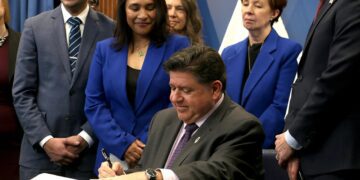By Frank J Biga III -
Donald Trump recently stated that not only will he balance the federal budget in eight years in office, but that he would pay off the nearly $19 Trillion in the national debt. Such talk has been dismissed as ludicrous by the talking heads in the Beltway press. Of course, these same luminaries saw his candidacy as a joke and were giving us weekly updates on how Trump had just peaked in the polls and would then lose the nomination to someone, anyone more conventional. So, I take their denunciations with a grain of salt.
But the big question is though, is this feat possible? Can the United States eliminate the deficit and then accumulate such astounding surpluses that the entirety of the national debt could be paid off? Could we become a debt free nation for the first time since the end of Andrew Jackson’s administration?
The answer, if one looks at the numbers, is yes. And the key to this lies in an understanding of what a balance sheet is. This concept seems to elude so many on the right these days as they only seem to reference the liability side of this equation. The US has $19 Trillion is debt. Illinois has an underfunded pension liability of $115 Billion. The US has about 100 Trillion in additional unfunded contingent liabilities hidden on a different set of books for Medicare and Social Security, among other programs. One hears these dire statistics practically every day. But these calls are short-sighted and only one side of the coin, or the balance sheet to be more accurate.
Yes, the United States probably has close to $140 Trillion in total government, student, consumer, mortgage and corporate debt. But, according to George Friedman in his book “The Next 100 Years” printed in 2009, the United States has total Assets of anywhere around 300 Trillion. With all of the new oil and natural gas deposits unleashed due to fracking, this number is now assuredly higher. So, if the United States has 300 Trillion plus in assets and around 140 Trillion in actual and contingent liabilities, then the picture for our country is not so bad as our Net Worth exceeds $160 Trillion. This might also explain why the US is able to finance its annual budget deficits at extremely low interest rates and not experience a bout of massive inflation. Our balance sheet is not as bad as the Chicken Little of the Right insist.
This also can help explain why Trump’s assertions that he can eliminate the deficits and pay off the national debt is 8 years is not so foolhardy. Let’s do some simple math on our country’s macroeconomic numbers. Our GDP is about $18 Trillion and if our Asset Base is about $300 Trillion, our Return on Assets is only about 6%. In other words, all of our assets are only producing an income stream (GDP) that would not be acceptable for a CEO of a Fortune 500 company. For instance, in 2015, Apple had a Return on Assets near 18%! Now Apple is special, so how about a more diversified Industrial company like say Honeywell? It was near 10%. Home Depot – 16%. Exxon Mobil – only 5% but crude prices are down and in the near past it was regularly around 8-9%.
My point is that the United States of America is and has been badly mismanaged. If we had better policies that unleashed he value of our Assets as well as our people and increased the Return on Assets to a more respectable 8%, then our GDP would approach $24 Trillion a year. That’s $ 6 Trillion more per year than now. Policies that could bring this about include lower marginal tax rates across the board for all income groups as well as higher tariffs for many goods coming in to this country to encourage more domestic investment in our abandoned factories.
It is unlikely we would have an immediate jump of $6 Trillion in GDP of course. Such moves take time. But this could certainly be achieved by the end of two terms in office if the above reforms were made – ones that focused on bringing more income to the people and companies of the United States. With 20 to 24 Trillion in GDP our economy would be a lot more dynamic and would generate more tax revenues to the government and suddenly $500 Billion deficits don’t seem so gargantuan. And if the Return on Assets could be brought up to 9% would a GDP of $27 Trillion, it is a near certainty that the entire National Debt could be paid off in 8 years. America would be great again.
Keep in mind that a Trump Administration could also engage in Asset Sales that could generate immediate cash for the government. Practically 1/3 of the land west of the Mississippi River is held by the Federal Government. Combine this with some serious spending cuts in discretionary spending like gutting the Departments of Education, Energy, and Commerce and this feat becomes even more manageable despite built-in increases in Social Security and Medicare.
So, the answer is undoubtedly yes. A President Trump could both eliminate the budget deficit and pay off the entire National Debt in two terms in office.







